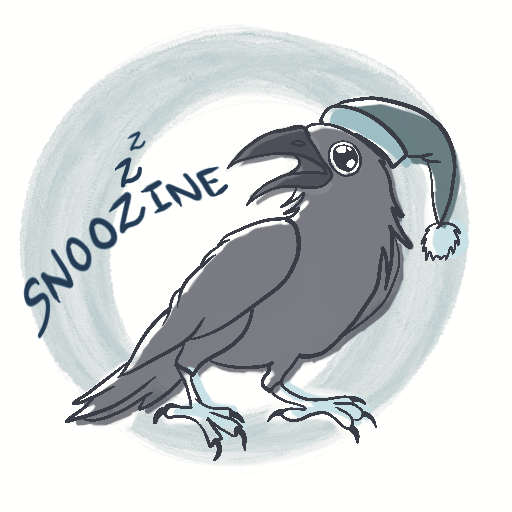We first met Jerome on a night when clouds wisped around the stars like a thin veil of cotton. We were sitting around a proverbial campfire when he swooped in, onyx feathers set apart from the blanket of night by the dying firelight. It was then, in that clash of hazy comfort from the fire and the foreboding promise of sinister things hiding in the shadows, that Jerome dictated to use what he envisioned for Snoozine: a literary magazine that captures every shade of night, from the dreams illuminated by the full moon to the doom brought on by the moon. And so we decided, with a helpful push from Jerome, to format each volume as a combination of two issues: dream and nightmare. For all issues, we want you to incorporate the unique mechanics of the dreamsphere, the odd sense of gravity that propels you through each turn of your innermost thoughts, but for each dream and nightmare issue, we encourage you to add a few extra filters.
Caught in the Clouds, Wrapped in Reverie
For dream issues, consider the pastel embrace of sleep. Cushion your pieces in softness. Although these issues aim for a certain coziness, you don’t always have to include happy endings, nor do you have to constrict yourself to traditional representations of pleasantry. The idea of falling out of sleep into the tenderness of dreams is simply an aesthetic filter. We want to see you apply any mode you’d like to that idea. Have an idea for a cozy fantasy story? Send it to us. Got some weird science fiction tucked away in your daydreams? We’d love to see it.
- Focus on Atmosphere and Comfort: Create a warm, inviting world where the reader feels at home. Emphasize elements like quaint villages, friendly characters, and magical elements that contribute to a sense of wonder and relaxation.
- Build a Convincing World: Whether it’s set in the future, an alternate reality, or a completely imagined world, ensure your setting is detailed and coherent. Consider how the speculative elements impact the culture, technology, and daily lives of the characters.
- Explore “What If” Scenarios: Use speculative fiction to examine hypothetical situations and their consequences. Think about how changes in technology, society, or environment might affect human behavior and relationships.
- Balance Concept and Character: While speculative fiction often revolves around big ideas, ensure your characters are well-developed and their personal stories are engaging. This balance keeps readers invested in both the conceptual and emotional aspects of your narrative.
Consumed by the Shadows, Greeted by Terror
Not every nightmare is terrifying, just like not every dream is necessarily good. Sometimes, a nightmare is classified by the layer of disgust slimed over the cold sweat coating your skin. For our nightmare issues, we don’t just want horror—although we are always open to traditional scares like murders and monsters. We want weird. We want unsettling. Uncanny. Think about liminal spaces and the backrooms, the sense of dread that pervades an empty and abandoned space. Get creative with your interpretation of nightmare, but make sure it affects us in the worst ways.
- Blend the Familiar with the Strange: Create a setting that feels normal but subtly introduces elements that are eerie or out of place. The uncanny often arises from the juxtaposition of the ordinary and the unsettling.
- Focus on Psychological Tension: Develop an atmosphere of creeping unease rather than outright horror. Use ambiguity, unreliable narrators, and psychological complexity to keep readers on edge.
- Leave Room for Interpretation: Allow some aspects of the story to remain mysterious or unexplained. This ambiguity can heighten the uncanny effect and leave readers pondering the implications long after they’ve finished the story.
Fly (Into Our Submissions) My Pretties!Take everything from the ideas in this post to heart when you submit to Snoozine. We’re so excited to see the dreams and nightmares you have in store for us. We’ll be roosting somewhere in dreamland.
